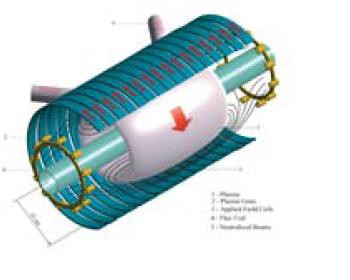The general principle behind fusion is relatively simple. If you can fuse together lightweight atoms, you can create a heavier atom plus lots of energy. The trick becomes that in order for the atoms to fuse together, enough energy needs to be provided to heat atoms into the range of 150 million degrees (Celsius). _Thomasnet
The current approaches to large scale fusion power have not been successful. Neither the large tokamak approach -- magnetically confined plasmas -- nor the laser inertial confinement approach as practised by Lawrence Livermore Lab, have provided significant returns for all the money that has been spent on them.
That is why the Los Alamos National Labs are trying a different approach, magnetised target fusion:
“We built a plasma injector, and they built a can-crusher, and you put the plasma into that aluminum canister, and then you crush the aluminum can, with the huge current produced by the capacitor bank,” Wurden began.More from Los Alamos Labs:
“”You put 11 million amps of current, and that produces a big magnetic field on the outside; that crushes the can very smoothly and uniformly.
“We put a magnetic field inside the can, we then inject the plasma from the magnetic field into the can; if the plasma’s in there and you do it right; we crush it by a factor of 10.”
Wurden then explained how the process works further.
“If you take a can from 10 centimeters in diameter to 1 centimeter of diameter; when you change the area by a factor of 100, the magnetic field in the can gets 100 times stronger than it was. This gives you a magnetic field of 5 million Gauss; and we have that plasma supported by this incredibly large magnetic field.
“We can hold the plasma together for 1/millionth of a second, at this incredible density and incredible temperature; we take the energy of motion in the can.
We’ve merged the technology of crushing a can, fast and smooth, with the plasma injector we have.”
Wurden, who has been working on fusion since 1977, said that the Magnetized Target Fusion approach is something in between the strictly magnetic fields approach, and the inertial compression approach used at the Livermore Lab in California. _Thomasnet
MTF is intermediate between magnetic confinement and inertial confinement fusion (ICF) in time and density scales. In contrast to direct, hydrodynamic compression of initially ambient-temperature fuel (e.g., ICF), MTF involves two steps: (1) formation of a warm (e.g., 100 eV), magnetized (e.g., 100 kG), wall-confined "target" plasma prior to implosion; (2) subsequent quasi-adiabatic compression by an imploding pusher, such as a magnetically driven imploding liner. In many ways, MTF can be considered a marriage between the traditional magnetic and inertial confinement approaches, which potentially eliminates some of the pitfalls of either. In particular, MTF requires simpler, smaller, and considerably less expensive systems than either magnetic confinement or inertial confinement ("laser") fusion. The instabilities which plague traditional approaches to fusion are potentially mitigated in MTF due to wall confinement, shockless acceleration and relatively low velocity (e.g 1 cm/m sec) of the pusher, and low required convergence ratios (e.g., 10:1). Similar to inertial confinement fusion (ICF), MTF relies on an implosion to compress a DT fuel to ignition conditions. Yet, also similar to magnetic fusion energy (MFE), MTF relies on a magnetic field to reduce the thermal diffusion of energy to the walls of a chamber. _LANL MTFThe LANL article goes on to describe the benefits obtained from their "hybrid" approach to fusion. But even with all the benefits of MTF, the researchers do not actually expect to achieve reliable fusion for at least 50 years.
That is where small fusion approaches come in: By trying so many different things, there is always the chance that one of the small fusion startups might create a winning technology. Here is a picture gallery of small fusion startups, borrowed from Al Fin Energy blog:
Bussard inertial electrostatic confinement fusion (EMC2 Fusion) involves an electrostatic plasma confinement to achieve fusion. The history and development of the concept is explained in a video reached via the link above. The Bussard IEC has been financed almost entirely by the US Navy. EMC2 is based near Santa Fe, New Mexico.
Lawrenceville Plasma Physics is based in New Jersey. The dense plasma focus approach uses a special pulsing "spark plug" to ionise a gas, and to form a plasmoid "pinch," with the emission of high energy photons, ions, and fusion neutrons.
Hyper V Technologies utilises a spherical array of mini railguns to accelerate plasma beams into a central target of deuterium or deuterium-tritium, to achieve fusion (hopefully).
TriAlpha is an Irvine, California venture, which has been fairly successful in the venture capital game. TriAlpha is a bit secretive with non-investors, but you can read their patent for yourselves. The concept seems to involve the highly sophisticated evolution from an earlier colliding beam fusion approach.
General Fusion is a small startup headquartered near Vancouver, BC. The compression of plasma to achieve fusion is accomplished by a coordinated spherical plasma compression, using pneumatics and advanced switching.
Helion Energy is located in Redmond, Washington. It is based on a principle of "colliding plasmas," and like all the rest of the small fusion approaches, it is a long shot.







No comments:
Post a Comment